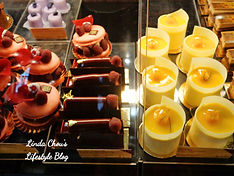
Viennese Café
The Legend
of
維也納咖啡館的傳奇故事
咖啡館是維也納特有的城市人文特色,這個約有189萬人口的城市,市區卻有兩千多家咖啡館, 密度可比台灣的超商,其中更有許多開店超過百年以上,歷史悠久又富傳奇故事的咖啡館,扮演塑造維也納文化的重要角色, 不僅當地愛好咖啡者流連其間,更是遊客體驗奧地利人生活與文化不可錯過的景點。
2011年10月"維也納咖啡館文化"被聯合國教科文組織UNESCO列為'非物質文化遺產', 和巴黎左岸的咖啡館文化,並列為歐陸兩大咖啡館文化。究竟喝咖啡的起源為何?維也納的咖啡館有甚麼迷人之處?在此分享關於咖啡起源的傳說, 維也納咖啡館的故事, 以及我2012年&2020年造訪維也納眾多咖啡館的體驗與感受。
咖啡的起源
維也納咖啡館文化的歷史可以追溯到西元1683 年,傳說波蘭-哈布斯堡軍隊的士兵從土耳其的圍困中解放維也納時,發現了一些裝著豆子的麻布袋,波蘭國王揚三世·索比斯基將(Jan III Sobieski)這些麻布袋給了一位名叫耶日·弗朗西斯澤克·庫爾茨基(Jerzy Franciszek Kulczycki)的軍官,他開始了喝咖啡的習慣。這個傳說被記載在天主教神父戈特弗裡德·烏利希(Gottfried Uhlich)於1783年發表的第二次土耳其圍攻歷史中。後來,庫爾茨基在咖啡裡加了一些糖和牛奶,維也納咖啡的傳統因而誕生。庫爾茨基的這項創舉受到許多維也納咖啡館認同,因而在許多維也納咖啡館櫥窗可以看到庫爾茨基的照片。另一種說法是,被奧斯曼帝國囚禁了兩年的庫爾茨基欺瞞上司讓他把那些被誤認為毫無價值的咖啡豆全部給了他。不論哪種傳說才是正確的, 咖啡因此成為維也納人最喜歡的飲品。傳統上, 維也納人也以第二次土耳其圍攻結束之日為"維也納咖啡館"誕生日"。1983年, 維也納甚至還歡慶“維也納咖啡館 300 週年”

維也納咖啡館的起源
據說第一家咖啡館實際上是由一位名叫約翰內斯·迪奧達託(Johannes Diodato)的亞美尼亞商人於 1685 年開設的。 15 年後,四家希臘人開設的咖啡館才開始營業。隨後幾個世紀,以維也納咖啡館為名的場所如雨後春筍般紛紛成立,上咖啡館蔚為風潮。漸漸地,咖啡館成為受歡迎的聚會場所, 人們激發靈感、交流和娛樂的地方。咖啡館成了很多人的第二個家,在那裡他們比較報紙的報導,舉行商務會議,整理他們的想法,或者與朋友和熟人打一局撞球或下棋。早期,各種飲料並沒有名稱,顧客會從顏色陰影圖表中選擇各式飲料。
維也納咖啡館文化
在英國,酒吧是人們交際應酬最常去的場所,奧地利人則視咖啡館為自家客廳的延伸,是交際應酬,聯絡感情的最佳場所。出生於維也納的作家漢斯‧維格爾(Hans Weigel)本身就酷愛咖啡館,他曾說:『咖啡彷彿已經成為人們靈魂的一部分, 就像啤酒之於巴伐利亞,威士忌之於蘇格蘭。』到咖啡館喝咖啡是奧地利人重要的社交活動並且足以和英國的下午茶傳統相提並論。
19世紀末到20世紀初,維也納咖啡館更是藝術家、思想家與知識分子聚會的熱門場所。他們在這裡尋找靈感,暢談時事,甚至策畫革命。咖啡館發展至今成為百家爭鳴的榮景,知名的老店更是將這咖啡館文化發揚光大成為維也納人文藝術的象徵。最彌足珍貴的是奧地利多數咖啡館可能換老闆卻不會倒閉,創立於西元1873年的蘭特曼咖啡館(CaféLandtmann)在原始老闆經營七年之後賣給他的兄弟們,其後即使先後幾度易手,仍然屹立不搖。擁有136年歷史的中央咖啡館(CaféCentral)雖曾在二次世界大戰期間歇業,但戰後還能復業,這股堅持或許是奧地利能保有眾多百年老咖啡館的因素。
維也納咖啡館的鼎盛時期是 19 世紀之交,當時 Peter Altenberg、Alfred Polgar、Egon Friedell、Karl Kraus、Hermann Broch 和 Friedrich Torberg 等作家將咖啡館作為他們首選的工作和娛樂場所。這一時期的許多著名藝術家、科學家和政治家,如亞瑟·施尼茨勒、斯蒂芬·茨威格、埃貢·席勒、古斯塔夫·克里姆特、阿道夫·盧斯、西奧多·赫茨爾、阿爾弗雷德·阿德勒甚至列昂·托洛茨基都是咖啡館的常客。
露天咖啡座首開先例
接待女客人
西元1750 年,一位咖啡師獲得了在咖啡館外擺設幾張桌椅的許可。德語所謂的Schanigarten, (酒吧花園)因而誕生, 這就是我們在維也納看到的露天咖啡座的由來。 1825 年,第一個經典的露天咖啡座誕生了,以桌椅和盆栽植物為邊界。
1840 年,女性才被允許進入咖啡館。起初,只接待由丈夫陪同出席晚會或舞會的女性。那時候,一個女人獨自到咖啡館會被視為想要結識男人, 之後,女性見面打牌和八卦才逐漸在維也納社會普及。所以, 咖啡館可說是維也納女人跨出禁錮的助力, 也是推翻不平等待遇的場所。


維也納咖啡館的特色
在奧地利不論城市鄉鎮,街頭巷尾,處處可見獨具巧思的咖啡館,挑高的空間,華麗的水晶燈和天花板、豪華的大理石桌面,咖啡館椅(Thonet 椅子)、報紙桌和蘊含歷史風格的室內設計細節, 典雅的沙發與窗簾,鑲著古色古香畫框的老相片等等營造懷舊風情,鋼琴演奏更添浪漫氣氛,男侍大都穿著西裝背心打著領帶或領結,女侍則圍著白色圍裙,讓人覺得上咖啡館是正式而優雅的休閒,享受喝咖啡的樂趣更是高度文明的象徵。 維也納咖啡館除了提供種類繁多的咖啡飲品、國際報紙和創意糕點。社會習俗和儀式感也優雅創造了維也納咖啡館非常特殊的氛圍。

咖啡館椅

創意糕點

刊物

大理石桌
在許多傳統的咖啡館, 晚上會有現場鋼琴演奏或在天氣溫暖的月份舉行文學朗讀等社交活動。在溫暖的季節,顧客經常可以坐在店外的露天雅座。


與世界各國的咖啡館傳統不同,除了咖啡,服務員還會提供一杯冷自來水。傳統上, 附一杯水是要給客人清潔味覺。玻璃杯頂部朝下的咖啡勺表明玻璃杯剛裝滿,這是傳承自哈布斯堡王朝的禮儀。
傳統的維也納咖啡館提供為種類眾多的報紙, 維也納當地的顧客獨自逗留數小時閱讀報紙是很普遍的事。


文人雅士生活的一部份
幾個世紀以來,咖啡館一直是維也納社會的非官方中心。 在這裡,政治家會見記者,演員會見劇院導演,作家寫書,其他人下棋或閱讀報紙。咖啡館是放鬆、思考和休閒的地方,是維也納人生活的一部份。
奧地利作家史蒂芬·茨威格(Stefan Zweig)描述維也納咖啡館"實際上就像是一個民主俱樂部,在這裡, 點一杯咖啡就可以坐上幾個小時,聊天、寫作、玩牌,還可以盡情閱讀免費的報紙和期刊"。在 19 世紀末和 20 世紀初,當時的主要作家經常約在咖啡館碰面、交流和寫作。在咖啡館創作的文學通常被稱為'咖啡館文學',其作家被稱為'咖啡館詩人'。據說卡爾克勞斯(Karl Kraus)的著名期刊 Die Fackel("The Torch""火炬”)大部分是在咖啡館裡寫的。其他咖啡館詩人包括 Arthur Schnitzler、Alfred Polgar、Friedrich Torberg 和 Egon Erwin Kisch。著名作家和詩人彼得·艾騰貝格(Peter Altenberg)因為很愛泡咖啡館, 甚至將他的郵件送到了他最喜歡的咖啡館 Café Central。他曾說:「如果我不在家,就是在咖啡館;如果不是在咖啡館,就是在前往咖啡館的路上」據說他在這裡走完人生最後一刻。因此,中央咖啡館為紀念這位三十年的老主顧,還在館內為他設立一座塑像(如右圖)。有關中央咖啡館的介紹請按下鍵前往閱讀全文


咖啡館'沒落時期'
1950年代,“濃縮咖啡”誕生, 由於只需很少的人力與技術,價格較低, 成為傳統咖啡館的競爭對手。加上電視逐漸普及,許多著名的維也納咖啡館不得不關閉。儘管如此,許多經典的維也納咖啡館仍然存在。旅遊業重新帶動人們對維也納的咖啡館傳統感興趣, 使得咖啡館得以捲土重來, 維也納的咖啡館文化得以繼續發揚光大。

在布拉格、布達佩斯、克拉科夫、的里雅斯特和利沃夫等奧匈帝國的城市,也有許多承襲維也納模式的咖啡館。維也納咖啡館文化隨後傳播到整個中歐,在這裡,作家、藝術家、音樂家、知識分子、一般客人齊聚一堂因而創造了一種特殊的多元文化氛圍。
之後, 哈布斯堡咖啡館的文化基礎被大屠殺和國家社會主義驅逐以及共產主義嚴重摧毀。只有維也納和少數地方仍保有這種特殊的咖啡館氣氛。1918年起歷經多次動蕩的義大利底里雅斯特(Trieste),當地人至今仍保留了以前維也納咖啡館的生活方式, 許多咖啡館仍保有昔日維也納咖啡館的風格, 例如Caffè Tommaseo、Caffè San Marco、Caffè degli Specchi、Caffè Tergesteo、Caffè Stella Polare , 。
對歐洲咖啡文化的影響

你會說咖啡的語言嗎?
維也納不僅擁有自己的咖啡文化,也創造了一些特別的咖啡語言。當維也納人說“Obers”時,指的是奶油。 “Schlagobers”是蓬鬆的鮮奶油, 常見咖啡上一坨鮮奶油當地稱為“Gupf”(一團塊狀的意思)。有趣的是 “Schlag”,另一個意思是一拳,在維也納的咖啡語言中是鮮奶油的意思,所以如果服務員問你「要不要“Kaffee mit Schlag”」,不是要給你一拳, 而是問你「要不要加鮮奶油」。
奧地利必吃美
維也納多元的美食文化象徵奧地利曾經是一個偉大的帝國。至今廣受喜愛的國民美食'清燉牛肉'源自匈牙利, '維也納炸肉排'實際上起源於義大利。維也納人對'清燉牛肉' (Tafelspitz) 以及'皇帝煎餅'(Kaiserschmarrn)等維也納傳統美食的喜愛與弗朗茨約瑟夫皇帝(Franz Joseph)有很深的淵源。
經典美食包含地位相當於台灣鳳梨酥的蘋果派(Apple strudel)、奧地利皇室最愛的皇家煎餅(Kaiserschmarrn)和Germknödel都是非常普遍的甜點。清燉牛肉(Tafelspitz),炸肉排(Wiener Schnitzel)和蘋果派並列奧地利國民美食,來到奧地利可別錯過這三大美食。有關奧地利美食的介紹請點下圖連結閱讀精彩故事。
皇室御用糕餅店
奧地利美食文化發展與皇室有密不可分的關聯, 只要是皇室愛吃的美食, 很快就會在民間流行開來, 維也納有幾間曾是皇室御用的糕餅店、至今仍門庭若市廣受全球觀光客喜愛的有共有三家, 分別介紹它們的傳奇故事如下:

Since 1876
薩赫酒店 Café Sacher
薩赫酒店創辦人的父親曾為奧地利國務總理服務並且發明了Sacher-Torte, 因而引發了與德梅爾糕餅店的官司
維也納最壯觀的咖啡館
維也納藝術史博物館 (Kunsthistorisches Museum Wien)是旅遊維也納不可錯過的藝術饗宴, 這座博物館裡的咖啡館極致美麗, 就位於整座博物館的中央, 四周由氣勢磅礡的拱廊環抱, 上方圓頂精雕細琢堪稱維也納最壯觀的咖啡館, 來到維也納沒來這個咖啡館瞻仰它的氣勢與壯觀會很遺憾,除了喝咖啡,用午, 晚餐,這裡每星期六, 日供應早餐, 可經由官網訂位, 請記得要買藝術史博物館門票入館後才能進去cafe, 請前往閱讀全文介紹
14家維也納咖啡館介紹
多次造訪維也納, 這裡特有的咖啡館文化最讓人欣賞的是咖啡館所供應的餐點糕餅都是各家主廚精心特製而非來自中央廚房或調理包。且每道餐點及甜點都別具特色,中央咖啡館(CaféCentral)甚至還出版了一本書來介紹該咖啡館歷史及食譜,這家老店的傳統維也納料理更曾獲得美食指南的表揚。該店糕點主廚從清晨3點就開始製作麵包及糕點,確保每天早上能以熱騰騰的早餐來迎接客人。
奧地利的咖啡館不只燈光好氣氛佳,供應的飲料多樣而豐富, Melange是奧地利特有的咖啡,類似卡布奇諾,一半是口感較溫和的摩卡咖啡,一半是熱牛奶,上面加上奶泡。Einspanner則是加上鮮奶油的咖啡,就像台灣的維也納咖啡。

















































